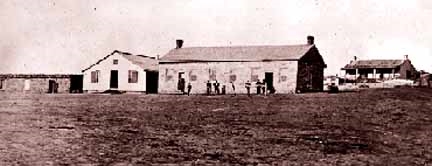(from The Deadliest Woman in the West: Mother Nature on the Prairies and Plains, 1800-1900, by Rod Beemer, 2006)

Colonel Richard Dodge was stationed in the West before and after serving as a Union officer in the Civil War. Following Lee’s surrender at Appomattox, Colonel Dodge was dispatched to the West where he saw duty during the Indian Wars. While stationed at Fort Dodge, KS, he gathered a stockpile of experience with blizzards. Col. Dodge writes:
“An exposure to the full force and fury of a violent “plains Norther” would be certain death to any indigenous animal. Buffalo and antelope fly before it, and seek protection in the deepest and most wooded cañons. Near Julesburg, I once saw the snow dotted with the bodies of a great number of snow-birds frozen to death in a storm of a few days before. Men suffer more than animals. Lacking the instinct of the latter, which enables them to presage the coming storm, men new to plains life, misled by the mildness of the ordinary winter weather, expose themselves possibly in light clothing on the plains, are caught in a storm, and perish miserably in a few hours.”
“A gentleman, competent and in a position to form a correct estimate, once told me that at least 100 buffalo-hunters had perished from cold in the country, within 100 miles of the Arkansas River, in two years. During the winter of 1872-3 I was in command at Fort Dodge, Kansas. At least seventy capital amputations were preformed by the post surgeon on citizens who were buffalo-hunters or railroad employés, whilst a much greater number of frozen men were sent East for treatment. I think it safe to say that over 200 men in that vicinity lost hands or feet, or parts of them…”
“The cold itself is not intolerable. The danger is from the sharp wind, which drives the cold like icy daggers through the body. Great suffering can always be avoided, if it be possible to get out of the wind…”
“The army frequently suffers greatly from these storms…At other times some military necessity…requires the movement of troops in mid-winter. The amount of suffering in all such cases can hardly be exaggerated…”
“In the winter of 1865-6 a considerable command was caught on the Cimarron, and barely escaped total destruction. An officer who was with it describes the sufferings as most fearful. Many men were more or less frosted, and about 600 animals frozen or starved to death.”
Another blizzard account:
“At Fort Dodge, during this same blizzard [1871-1872], thousands of buffalo sought shelter around the walls of the post and on the lee side of buildings. At regular intervals artillery pieces were fired in an effort to keep the buffalo from crowding against and pushing down all the fort’s buildings and corrals.
“Buffalo hunters caught away from adequate shelter by this storm found themselves in serious trouble. The thermometer fell to twenty below zero °F and the wind was howling at sixty miles an hour. A hunter named Happy Jack and his outfit were camped near Five Mile Hollow when the blizzard struck. “Every man in the outfit froze to death that night; and there was also a big Newfoundland dog froze to death lying on the bed.”
Reprinted with permission of Caxton Press.
